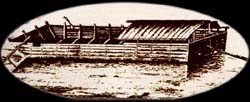 Illinoistown
Illinoistown Illinoistown
Illinoistown |
In the early years of Illinoistown it is clear that Samuel Wiggins, a politician and Illinois businessman, was an influential presence. The Reverend John Mason Peck described the town as a small one of about a dozen families with a post office, hotel, livery, and store. The post office was called Wiggins Ferry and Samuel was the postmaster.
Although a flood in 1826 (only one of many to damage the area) may have set back the growth of Illinoistown, Wiggins' concentrated ferry business helped spawn economic growth throughout the 1820s and 1830s. According to a study by the National Park Service, by 1841 Illinoistown had become a bustling place with numerous grocery stores, two bakeries, a clothier, a cooper, blacksmiths, taverns and hotels. There were more than one hundred homes and a newspaper, The American Bottom Reporter.
Samuel Wiggins was apparently not a person to have others do his work. He was involved in the lives of the people living in and around Illinoistown as an excerpt from William Wells Brown's narrative shows.
The first thirty years of the nineteenth century marked a period of regular growth along either side of the Mississippi. St. Louis was established as the largest city in the region and a central starting point for people heading west. The community on the Illinois side was growing as well, providing passage to St. Louis.
Steamboats brought Illinoistown and St. Louis a variety of new ventures. Steamboats needed fueling stations and a means of transporting their goods once ashore. The local ferry operations were a natural fit, developing shore facilities for steamboats and already possessing the ability to quickly move goods across the river at low cost. By 1828 the Wiggins operation had converted its ferries to steam, taking advantage of its renovated facilities and the fairly low cost of constructing a steamboat.